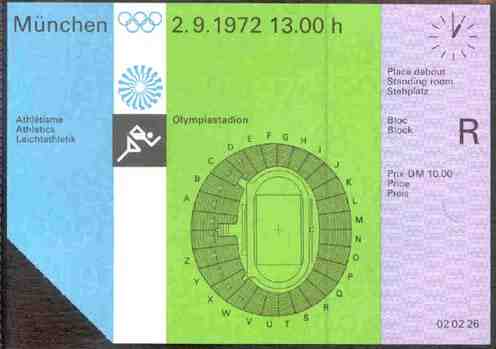| Admission Ticket Coding 1972
At the start of 1971 the OC began to mark
the approximately 1,150 different types of tickets with special code numbers.
In this way the OC simplified identification for advance sales which would
proceed on the basis of vouchers. The OC chose a socalled "tell-tale-key"
in order to reduce this tedious work to dimensions possible for the sales
personnel. As a result it was necessary to have six-place code numbers
to earmark every type of ticket.
The first two digits, called the lead digits,
marked the specific sport type or event. For example, 01 represented the
opening ceremony, 02 track and field, 03 rowing, until 23, the closing
ceremony.
The third and fourth digits gave the date,
that is, 26=August 26 or 01=September 1. An overlapping of dates in August
and September did not occur.
The fifth digit signified the event period
on the event day in question and therewith distinguished between the morning
and afternoon events and afternoon and evening competitions.
The sixth and final digit referred to one
of the six possible price categories.
Graphic Lay-Out
The admission tickets had to provide as much
necessary information as possible. They had to state the place, date and
time of the respective competition and should also help the spectator find
his place quickly and easily in every stadium.
The Design
The tickets were 105 mm x 148.5 mm (about
the size of a postcard). The obverse was divided into four adjoining vertical
sections of varying widths which gave rise to a field of nine sections
1 6.5 mm wide.
Variable Data
The OC had the following bits of information
printed in the four sections:
Section 1:
The name of one of the twenty-three events
(twenty-one sports events as well as the opening and closing ceremonies)
and the consecutive numbering for every event place beginning with 00001
(first place of the highest price category) and ending with the last place
in the lowest
price group.
Section 2:
Twenty-one sporting event symbols and the
official emblem with the Olympic rings. The color in this section corresponded
to the basic color of section 1, for example, silver for the opening and
closing ceremonies, blue for the other sports events.
Section 3:
The sixteen dates in digits along with twenty-seven
time markings for every half hour and the thirty-six competition sites
(name and ground plan, as an important placing information especially for
large stadiums).
Section 4:
Representation of the most important information
needed at a glance, in especially large and recognizable contrast, namely:
twenty-seven time markings in clockface form for every half hour, a maximum
of 152 block entries (capital letters and large Arabic numerals) per sports
site, a maximum of eighty-four rows, a maximum of forty-seven seat numbers,
a maximum of six price categories, the price in D-marks, and the code number
of twelve digits.
With the exception of the emblems and sports
site markings, all data was printed in black and in three languages.
Variable Colors
The basic colors for section 1 (silver for
the opening and closing ceremonies; blue for all other sports events) and
section 2 (white) were quickly settled. In contrast the OC let sections
3 and 4 have different colors to provide an optically distinguishable marking
for valid and invalid tickets for the ticket-takers at the gates. The colors
themselves were taken from the official colors chosen for the visual image
of the Olympic Games in Munich.
1.
Color scheme of the contest sites in section
3:
The thirty-six competition sites were marked
in seven different colors. They were not guilloched. Sports sites separated
from each other by long distances, received the same basic color, whereas
those clustered together were easily distinguished by various colors. The
color for Olympic Stadium (light green), the swimming hall (dark blue)
and the sports hall (yellow) were not repeated, and the four halls on the
fairgrounds were marked with the four remaining basic colors (orange, light
blue, dark green and grey).
2.
Color scheme of the event days in section
4:
These were also marked by means of seven
different basic colors (gray, yellow, blue, brown, turquoise, chartreuse
and violet). They repeated themselves after the eighth day of events but
never agreed in color with section 3. In contrast to sections 1, 2 and
3, section 4 was guilloched. The OC planned these two color color schemes
within a small group. Until the original tickets were printed, the OC identified
the colors with the Roman numerals I to VII for the competition sites in
section 3, and Arabic numerals 1 to 7 for the competition days in section
4.
The Reverse of the Tickets
The solid gray reverse of the tickets was
divided into three vertical fields and relayed the following information:
Field 2:
Large lay-out scheme for finding the sports
sites by means of maps and verbal explanations with four variations:
A: simplified map of Olympic Park
for all
events
in the area,
B: simplified city map
of Munich showing every sports site for those events
taking
place out-side of Olympic Park or in the Munich area.
C: schematic representation
of Kieler Förde designating the areas for the
ceremonial
plaza or the berths.
D: blank for all other events.
Field 3:
Advertising (emblem of a German automobile
firm and a text in three languages).
(Source document: Official
Report 1972, Vol. 1, page 308) |

